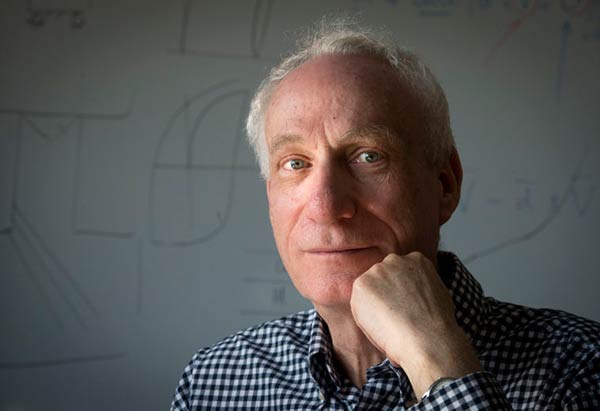Materials Mechanics Beyond the Horizon
Celebrating the 80th Anniversary of Alan Needleman
May 26 - 28, 2024 / Madrid, Spain
Materials Mechanics Beyond the Horizon
Celebrating the 80th Anniversary of Alan Needleman
May 26 - 28, 2024 / Madrid, Spain
For over 50 years, Alan Needleman has been an influential figure in the field of Mechanics of Materials, inspiring both his peers and the younger generation of researchers with his passion and energy.
His innovative ideas and pioneering works have enabled the field to expand its boundaries and explore new frontiers of research.

Alan obtained his Ph.D. from Harvard University in 1970 under the supervision of Professor John Hutchinson. His PhD work covered periodic arrays of voids, large deformation plasticity, and nonlinear finite element computation, which laid the foundation for much of his subsequent research. After completing his Ph.D., Alan joined MIT as an Assistant Professor in the Mathematics Department, where he focused on numerical methods for nonlinear problems. During his time at MIT, he met Viggo Tvergaard at the Technical University of Denmark, and they began a lifelong collaboration initially on buckling in structures, which soon shifted to bifurcation and localization problems in tensile bars and sheets.
In 1975, Alan moved to Brown University, where he and Viggo picked up on the idea that void nucleation and growth are key to ductile fracture. They adopted and extended the yield function for porous plastic material developed by Gurson (as a student of Jim Rice at Brown) to account for the entire chain of the nucleation, growth, and coalescence of voids. This model, often referred to as the Gurson-Tvergaard-Needleman model, is at the heart of the so-called local approach to fracture. It has proved to be able to simulate real, complex fracture phenomena and has become a day-to-day tool for engineering and scientific analysis.
In the late 1970s, Alan focused on the coupling of grain boundary diffusion and plastic creep in polycrystalline metals, inspired largely by the ideas of Jim Rice. There could be a synergistic effect between plastic deformation and the shortening of diffusion lengths. Numerical calculations were required to quantify this. Alan's finite element formulation involved creating a stiffness matrix with surface terms accounting for grain boundary diffusion in addition to the usual volumetric terms. The calculations quantified a significant synergistic effect.
In the 1980s, again inspired by Jim Rice, Alan and Viggo became involved in research on plastic flow localization, while Bob Asaro was investigating localized deformation in single crystals experimentally. Alan, in work with Asaro and Peirce, showed that accounting for material rate dependence in crystal plasticity calculations could simulate the observed deformation responses remarkably well. An issue with the rate-independent localization calculations was that the formulation did not contain a material length scale. The band thickness and hence the post-localization response were essentially determined by the finite element discretization rather than by any mechanism embedded in the modeling. The introduction of a length scale was effectively achieved through material rate dependence.
In the mid-1990s, experiments on metal thin wires and sheets revealed that resistance to plastic deformation tends to increase as the size decreases. These phenomena could not be explained by existing plasticity models, including crystal plasticity. Alan recognized the potential of describing these phenomena in terms of the motion of carriers of plasticity, dislocations. Together with Van der Giessen, he developed a formulation of discrete dislocation plasticity that combined analytical closed-form solutions for individual dislocations in infinite space with a finite element solution for a supplementary field that accounts for boundary conditions. The field of discrete dislocation plasticity began with a few researchers, notably Deshpande and Benzerga, and expanded rapidly, particularly when their students also started adopting the method, leading to the emergence of a new area of study.
Alan's other notable innovations include the development of cohesive zones (or surfaces) that are now a standard tool in the field. In the early 1990s, he and Viggo conducted dynamic 3D ductile fracture studies to avoid excessively large sizes of 3D finite element stiffness matrices, being among the first to use massively parallel computing in computational mechanics. Using similar techniques, Alan and Viggo made significant progress from individual voids to real ductile failure. After retiring from Brown, Alan joined the University of North Texas (UNT). While at UNT, Alan and Viggo in collaboration with Elisabeth Bouchaud showed that proper simulations accounting for void nucleation, growth, and coalescence can predict fracture surfaces with self-affine properties that agree with experimental results. This work bridges the gap between the materials science community, which emphasizes physical mechanisms, and experimental/theoretical physics, which has claimed fractality of fracture surfaces for many years. In 2015, Alan moved to Texas A&M University, where he has actively helped expand the research portfolio of the department of Materials Science and Engineering. At Texas A&M, his research has focused mainly on discrete defect plasticity and the inference of constitutive parameters using Bayesian statistics.
The summary above of Alan's scientific legacy cannot provide a complete overview of all his articles. Despite his main priority being in research, Alan has also been involved in numerous professional activities such as serving on various review committees, editorial advisory boards, and advisory committees of organizations like the American Society of Mechanical Engineers. His main administrative duty, however, was serving as the Dean of Engineering at Brown University for three years starting from 1988. Finally, the numerous awards and accolades that Alan has received throughout his distinguished career include the Timoshenko (2011) and Drucker (2006) medals from the American Society of Mechanical Engineers, and the Prager Medal (2006) from the Society of Engineering Science. Alan is also an Honorary Member (since 2018) of the American Society of Mechanical Engineers, a Member (since 2007) of the American Academy of Arts and Sciences, and a member (since 2000) of the US National Academy of Engineering.